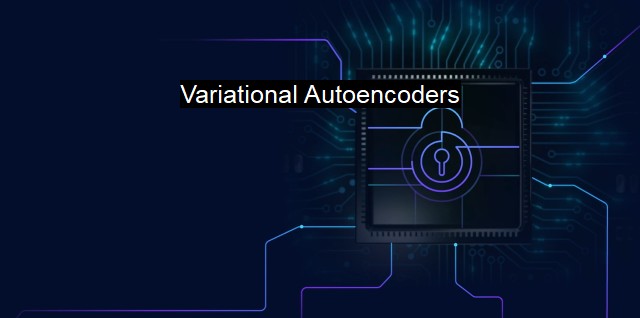What are Variational Autoencoders?
Securing the Future: Variational Autoencoders - Exploring their Potential as Cybersecurity and Antivirus Tools
Variational Autoencoders (VAEs) are a class of deep learning methods that utilize neural networks for high-level representation of input data, enabling advanced data analysis through learning a product of posterior probabilities. VAE combines notions from deep learning, probability theory, and generative model techniques to accomplish a range of goals including unsupervised learning, generating new sample data from the learned distribution, and dimensionality reduction.In the context of cybersecurity and antivirus applications, VAEs may revolutionize how threats are detected and neutralized. As cyber threats become more sophisticated and evasion techniques correspondingly advance, traditional security mechanisms and heuristics struggle to keep pace.
Understanding the nature of VAEs begins with some technical terms. Autoencoders represent a class of artificial neural networks employed to learn efficient codings of input data. Conceptually, they consist of two main components, the encoder, which compresses the input data, and the decoder, which reconstructs the original data from the compressed form. A 'variational' Autoencoder differs from a simple one in that, instead of encoding an input as a single point, it encodes it as a distribution.
The functioning of VAEs aligns with the requirements of cybersecurity applications in promising ways. By learning to identify patterns in the input data, they offer a methodology aligned with anomaly detection, making them an indispensable tool in creating advanced cybersecurity systems.
VAEs learn the normal pattern of system behavior through historical network or system data. Hence if a cyber threat results in any significant deviation from the learned normal pattern, the VAE would be able to detect and alert such anomaly pattern. Being unsupervised learning models, VAEs reduce reliance on labeled datasets for model training, which are rare in the cybersecurity domain.
VAEs can generate new samples from learned distributions of normal system behavior. This distinct capability makes them a powerful tool for anomaly simulation, that can help in training and tuning cybersecurity and antivirus applications to better anticipate and tackle novel threats, enhancing threat modeling significantly.
Dimensionality reduction, another feature of VAEs, can simplify the complexity associated with high dimensional cyber threat data. VAE allows reducing input data into lower dimensionality latent space and accurately maintain vital data attributes while simultaneously reducing noise. This simplification facilitates faster, robust anomaly detection, and effective threat classification.
Also, being probabilistic generative models, VAEs can cope effectively with data variety and uncertainties common in the cybersecurity domain, leading to more accurate anomaly detection. VAE transformations offer a non-linear dimensionality reduction, which minimizes the risk of information loss during transformation and improves cybersecurity's predictive accuracy.
Variational Autoencoders equipped with deep learning, probabilistic, and generative model capabilities have an exciting potential in cybersecurity. They can observe regular system patterns, anticipating any deviation, hence accelerating anomaly detection, improving alarm systems, enriching threat modeling through simulation, and optimizing threat analysis via dimensionality reduction. With the rapidly evolving landscape of cyber threats, the adaptability and learning capabilities of Variational Autoencoders play a crucial role in protecting our cyberspace, making them a component of modern cybersecurity solutions.
That said, it is also crucial to ensure ethical usage of VAEs, as in wrong hands these powerful capabilities can also enable adversaries to "learn" normal system patterns, countersignature defenses, and test attacks offline for better evasion, leading to an arms race between cybersecurity developers and cybercriminals. In preventing these downside risks, governance of AI ethics, constraints, and controls will play an amplifying role in ensuring VAEs are solely used for raising the bar on cybersecurity services.

Variational Autoencoders FAQs
What is a Variational Autoencoder (VAE)?
A Variational Autoencoder (VAE) is a type of neural network used in machine learning that can be used for unsupervised learning of complex data. VAEs learn to represent input data in a lower-dimensional space, and can be used to generate new data that belongs to the same distribution as the training data.What is the role of Variational Autoencoders in Cybersecurity?
Variational Autoencoders (VAEs) can be used in cybersecurity for anomaly detection, by learning to distinguish between normal and abnormal patterns in network traffic or system logs. VAEs can also be trained to generate synthetic data, which can be used for data augmentation or to test security systems against simulated attacks.How do Variational Autoencoders improve the performance of antivirus software?
Variational Autoencoders (VAEs) can be used to improve the performance of antivirus software by learning to identify malware patterns that are not easily detectable by traditional signature-based methods. VAEs can also be used to generate new malware signatures that can be added to antivirus databases to enhance their detection capabilities.What are the limitations of using Variational Autoencoders in Cybersecurity?
One of the limitations of using Variational Autoencoders (VAEs) in cybersecurity is that they require large amounts of training data to learn how to accurately distinguish between normal and abnormal patterns. VAEs can also be vulnerable to adversarial attacks, where an attacker can manipulate data to evade detection by the VAE. Additionally, VAEs are computationally intensive and may not be practical for real-time cybersecurity applications.| | A | | | B | | | C | | | D | | | E | | | F | | | G | | | H | | | I | | | J | | | K | | | L | | | M | |
| | N | | | O | | | P | | | Q | | | R | | | S | | | T | | | U | | | V | | | W | | | X | | | Y | | | Z | |
| | 1 | | | 2 | | | 3 | | | 4 | | | 7 | | | 8 | | |||||||